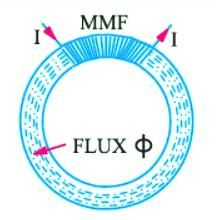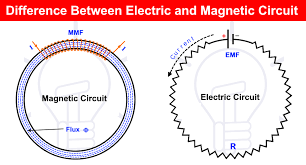Comparison Between Magnetic and Electric Circuits
1
| Magnetic Circuit | Electric Circuit |
 |  |
| M.M.F. (ampere-turns) | E.M.F. (volts) |
| Flux Φ (webers) | Current I (amperes) |
| Flux density B (Wb/m2) | Current density (A/m2) |
| Reluctance S | |
| Permeance (= 1/reluctance) | Conductance (= 1/resistance) |
| Reluctivity | Resistivity |
| Permeability (= 1/reluctivity) | Conductivity (= 1/resistivity) |
| Total m.m.f. = Φ S1 + Φ S2 + Φ S3 + ….. | 9. Total e.m.f. = IR1 + IR2 + IR3 + ….. |
AdBlock-2
Differences Between Magnetic and Electric Circuits
1. Strictly speaking, flux does not actually ‘flow’ in the sense in which an electric current flows.
2. If temperature is kept constant, then resistance of an electric circuit is constant and is independent of the current strength (or current density). On the other hand, the reluctance of a magnetic circuit does depend on flux (and hence flux density) established in it. It is so because μ (which equals the slope of B/H curve) is not constant even for a given material as it depends on the flux density B. Value of μ is large for low value of B and vice-versa. Hence, reluctance is small (S = l/μA) for small values of B and large for large values of B.
3. Flow of current in an electric circuit involves continuous expenditure of energy but in a magnetic circuit, energy is needed only creating the flux initially but not for maintaining it.
Read article – magnetic circuit
Visit NCERTplanet.com for NCERT solutions and Textbook downloads

